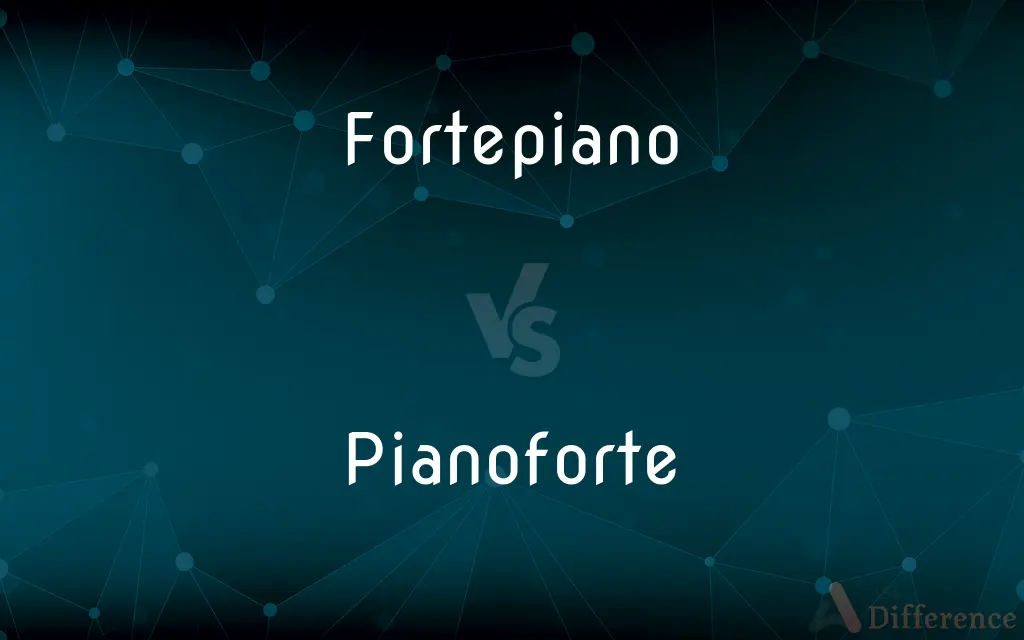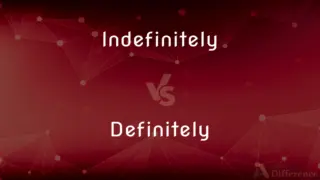Fortepiano vs. Pianoforte — What's the Difference?
Edited by Tayyaba Rehman — By Urooj Arif — Updated on April 2, 2024
Fortepiano and pianoforte refer to the same early version of the piano, yet the term fortepiano often denotes instruments from the 18th and early 19th centuries.

Difference Between Fortepiano and Pianoforte
Table of Contents
ADVERTISEMENT
Key Differences
The fortepiano and the pianoforte are two names for the same instrument, which is the precursor to the modern piano. The term "fortepiano" is derived from the Italian words "forte" (loud) and "piano" (soft), highlighting the instrument's capability to produce sounds with varying dynamics, unlike its predecessors. Whereas, "pianoforte" is simply these terms reversed, emphasizing the same characteristic of dynamic range but is more commonly used in some languages and historical contexts.
The fortepiano and pianoforte were used interchangeably to describe the early keyboard instrument invented by Bartolomeo Cristofori in the early 18th century. This instrument was revolutionary because it allowed performers to play notes with different levels of volume depending on how hard they struck the keys. Over time, however, the term "fortepiano" has come to specifically denote the earlier versions of the instrument, particularly those used in the 18th and early 19th centuries, which have a lighter and more delicate sound than modern pianos. "Pianoforte" is often used to refer to the instrument throughout its history, including both the early versions and the more developed forms that closer resemble the modern piano. The pianoforte of the late 19th century, for example, had undergone significant developments in terms of mechanism and sound production, leading to a richer and more powerful sound that paved the way for the modern concert grand piano.
The construction and mechanics of the fortepiano differ from those of later pianofortes and modern pianos. Fortepianos typically have a lighter frame and thinner strings, which contribute to their distinct sound quality. They also often feature fewer keys than modern pianos. In contrast, the pianoforte, especially as it evolved, included innovations such as the use of metal frames and thicker strings, leading to a greater volume and the ability to sustain notes longer.
Musicians and composers of the Classical era, such as Mozart, Haydn, and early Beethoven, composed specifically for the fortepiano, taking advantage of its expressive capabilities. The evolution of the pianoforte throughout the 19th century aligned with the Romantic movement, accommodating and inspiring composers like Chopin, Liszt, and later Beethoven, who sought a broader dynamic range and more sonorous quality.
In contemporary contexts, the preference for the term "fortepiano" or "pianoforte" can also reflect a focus on historically informed performance practices. Musicians specializing in the performance of 18th and early 19th-century music often prefer the fortepiano for its authentic sound, which is more faithful to the timbre and dynamics of the period's music. Meanwhile, the broader term "pianoforte" can encompass a wider range of historical and modern instruments, acknowledging the continuous evolution of the piano.
ADVERTISEMENT
Comparison Chart
Time Period
18th and early 19th centuries
Broadly used for instruments from the 18th century to present
Sound Quality
Lighter, more delicate
Richer, capable of greater volume and sustain
Construction
Lighter frame, thinner strings, fewer keys
Heavier frame, thicker strings, more keys as time progressed
Composers
Mozart, Haydn, early Beethoven
Chopin, Liszt, later Beethoven
Historical Use
Used interchangeably with pianoforte, now denotes earlier models
Used throughout its development, including modern pianos
Performance Practice
Preferred for historically informed performances of Classical era music
Encompasses a wider range of music, including Romantic and later works
Compare with Definitions
Fortepiano
Dynamic Range.
Performers on the fortepiano exploited its dynamic contrasts to enhance musical phrasing.
Pianoforte
Evolutionary Design.
The pianoforte underwent significant modifications to become the modern piano.
Fortepiano
Construction.
With its lighter construction, the fortepiano offers a distinct touch compared to modern pianos.
Pianoforte
Dynamic Capability.
The pianoforte's capacity for loud and soft play influenced the development of musical dynamics.
Fortepiano
Sound Characteristics.
The fortepiano's sound is characterized by clarity and transparency, ideal for Classical repertoire.
Pianoforte
Technological Advances.
Advances in pianoforte design, like the iron frame, enabled the powerful sound of contemporary pianos.
Fortepiano
Early Instrument.
The fortepiano's design allowed for nuanced expression, captivating audiences of the 18th century.
Pianoforte
Sound Evolution.
Over time, the pianoforte's sound became fuller and more resonant, suitable for larger concert halls.
Fortepiano
Historical Context.
The fortepiano was the instrument for which Mozart composed his piano concertos.
Pianoforte
Broad Use.
The pianoforte served as the primary keyboard instrument from the Classical period through the Romantic era.
Fortepiano
A fortepiano [ˌfɔrteˈpjaːno] is an early piano. In principle, the word "fortepiano" can designate any piano dating from the invention of the instrument by Bartolomeo Cristofori around 1700 up to the early 19th century.
Pianoforte
A piano.
Fortepiano
Any of various precursors to the modern piano.
Pianoforte
A piano.
Fortepiano
A keyboard instrument; the smaller, quieter precursor to the pianoforte.
Pianoforte
A stringed instrument that is played by depressing keys that cause hammers to strike tuned strings and produce sounds
Common Curiosities
Why do some musicians prefer to play the fortepiano?
Some musicians prefer the fortepiano for its authentic sound and expressive capabilities, especially when performing music from the Classical era.
How has the construction of the pianoforte influenced modern piano manufacturing?
The construction innovations of the 19th-century pianoforte, such as the use of a cast iron frame for greater string tension and durability, have directly influenced modern piano manufacturing, allowing for larger, more powerful instruments capable of filling concert halls with sound.
Can modern music be played on a fortepiano?
While possible, the fortepiano's range and sound may not fully capture the dynamics and tonal qualities of much modern music.
How do the mechanisms of the fortepiano and modern pianoforte differ?
The fortepiano features a simpler action mechanism that results in a more immediate touch and a quicker release than the modern pianoforte, which has a more complex action that allows for greater control over dynamics and sustain.
What is the difference between a fortepiano and a pianoforte?
The main difference lies in their historical context and usage; "fortepiano" often refers to the early versions of the instrument with a lighter sound, while "pianoforte" can refer to the instrument throughout its history.
Why are there two names for the same instrument?
The two names reflect the instrument's capability for dynamic expression, with "fortepiano" highlighting the contrast between loud and soft, and "pianoforte" emphasizing the same feature in reverse order.
Were there any significant composers who transitioned from composing for the fortepiano to the pianoforte?
Beethoven is a notable example of a composer who transitioned from composing for the fortepiano to utilizing the fuller capabilities of the evolving pianoforte, reflecting this shift in his later works with their greater demands on volume and expressiveness.
How did the sound of the pianoforte evolve over time?
The sound of the pianoforte evolved to become richer, louder, and more sustained, thanks to technological advances in construction.
Is the repertoire for the fortepiano different from that of the pianoforte?
Yes, the repertoire for the fortepiano typically includes works from the Baroque to the early Romantic periods, highlighting the instrument's expressive capabilities within those styles. The pianoforte's repertoire, however, spans from the Romantic period to contemporary music, taking advantage of its broader dynamic range and tonal richness.
What role did the fortepiano and pianoforte play in the development of music composition?
The fortepiano and pianoforte played crucial roles in the development of music composition by expanding the possibilities for dynamic expression and emotional depth. Composers were able to write more complex and expressive music, taking advantage of the instruments' evolving capabilities to explore new textures, forms, and harmonic languages.
Share Your Discovery

Previous Comparison
Dust vs. Sand
Next Comparison
Indefinitely vs. DefinitelyAuthor Spotlight
Written by
Urooj ArifUrooj is a skilled content writer at Ask Difference, known for her exceptional ability to simplify complex topics into engaging and informative content. With a passion for research and a flair for clear, concise writing, she consistently delivers articles that resonate with our diverse audience.
Edited by
Tayyaba RehmanTayyaba Rehman is a distinguished writer, currently serving as a primary contributor to askdifference.com. As a researcher in semantics and etymology, Tayyaba's passion for the complexity of languages and their distinctions has found a perfect home on the platform. Tayyaba delves into the intricacies of language, distinguishing between commonly confused words and phrases, thereby providing clarity for readers worldwide.













































